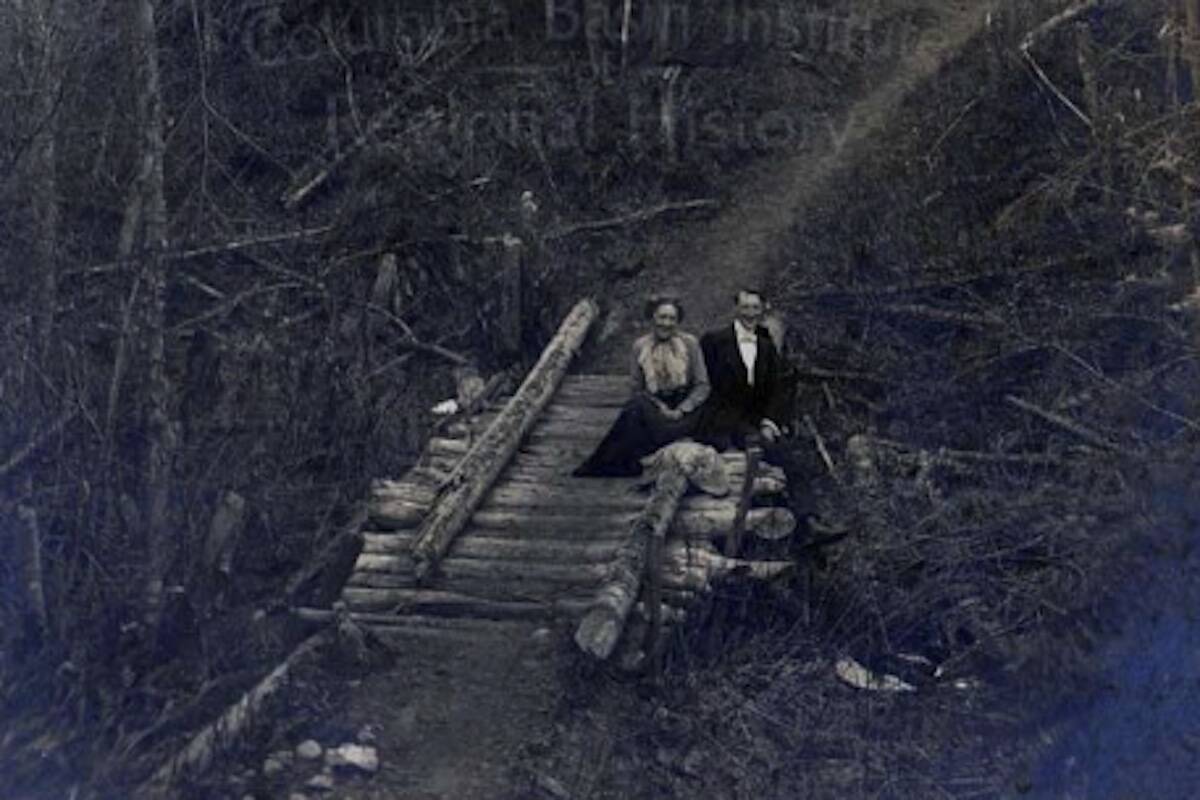A column by Bruce Uzelman
Edgar Dewdney’s trail was constructed to Fort Steele, then known as Galbraith’s Ferry, in 1865. The trail terminated just a few miles beyond at Fisherville, a gold camp on the Wild Horse River, also referred to as the Wild Horse Creek. Dewdney contracted the construction of the eastern section of the trail to William Fernie, who would later found the town bearing his name.
John Galbraith had arrived in the Kootenays in 1864. He operated a ferry across the Kootenay River at the mouth of the Wild Horse, providing access to the area for the miners. He also operated a general store there, and founded the town of Galbraith’s Ferry.
Information is sparse on the town at the time. Dewdney took note of “scores of saloons and dance halls,” but said little beyond that. There likely were at least one hotel, perhaps several, and a number of merchants. The population was claimed to be 3000 people.
Looming over the settlement of Fisherville and the entire area was Mount Fisher. Both were named for Jack Fisher, who had staked an early claim there in 1864. Fisherville survived only to 1866. A rich deposit of gold was found beneath it. The buildings were razed or dismantled and moved.
The 1864 gold commissioner’s report noted good results on the Wild Horse, “50 sluice companies were at work, employing from 5 to 25 men, and taking out from $300 to $1000 per diem.” Miners in Fisherville used hydraulic mining with great success. Bob Dore extracted over $500,000 in gold with the technique. A miner recovered a 36 ounce nugget from the river, amongst B.C.’s largest ever.
The rush was vigorous, but short. By 1866, yields were much reduced. Within a few years, there were fewer than one hundred residents remaining in Galbraith’s Ferry. But it was not the end.
In 1887, a North West Mounted Police detachment was established at Galbraith’s Ferry to calm tensions between the resident Ktunaxa indigenous people and settlers. The detachment was under the command of Superintendent Sam Steele. The detachment was short-lived, but residents of the town renamed it Fort Steele in 1888 in honour of the man who had defused the conflict.
About the same time mining began to pick up again. Hard rock mining came to dominate. An 1895 edition of The Prospector newspaper lists a number of operating mines in the Fort Steele area, and boasts, “the future [prosperity] of Fort Steele as a mining centre is assured fact.”
In 1892, Fort Steele only contained government offices, two stores, one hotel and of course homes. In 1897, five hotels were added. In 1899, the newspaper lists four general merchandise stores, a great number of specialty stores, a hardware store, a bakery, assorted trades and services and a brewery. The town was serviced by three doctors and a law practice. Times were good!
The town was surveyed in 1894, in time for the developing building boom. The Fort Steele Mercantile soon added building supplies. Construction picked up in anticipation of the railroad arriving in Fort Steele, the most developed town in the area.
In 1898, however, the CPR routed their Crow’s Nest rail line through Cranbrook, a new town established by Colonel James Baker. Baker reportedly agreed to grant the railroad every second lot in the townsite, while Robert Galbraith refused to provide any of his significant land holdings in Fort Steele to the CPR. The rail line bypassed Fort Steele, and so began the second decline of the town.
In 1901, the province granted a railway charter to a company based in Fort Steele. The rail line was to link the CPR Crow’s Nest line with the CPR mainline at Golden. Fort Steele was on the route. The project was much delayed. Finally in 1909, the CPR bought the company, and by 1910 the line was under construction. The first train arrived at Fort Steele in December of 1914. But the die had long since been cast. The ascent of Cranbrook and the decline of Fort Steele was irreversible.
Development of the Kootenay had begun with Edgar Dewdney’s trail in 1865. It served its purpose. By the end of the century, the trail had been replaced by wagon roads and the railroads.
Dewdney, after his trail building, went on to a political career with multiple terms as an MP, and as a cabinet minister under Prime Minister John A. McDonald. He served as Lieutenant-Governor of the sprawling North West Territories (before Alberta and Saskatchewan were carved from it) and later as Lieutenant-Governor of B.C.
Many Canadians know who Lewis and Clark were – they were Americans who discovered a land route across the U.S., creating an American presence throughout the West – but few know who Edgar Dewdney was. With his trail, he secured B.C. for Britain and for Canada, establishing the province as we know it. That is every bit as remarkable and memorable as the role played by … the other guys. Umm, can’t recall their names!
READ MORE: The Old West: The Dewdney Trail and Fort Steele – Part 1
Bruce Uzelman, based in Kelowna, holds interests in British Columbia history as wells as current political and economic issues.
Bruce had a career in small business, primarily restaurant and retail. He holds a Bachelor of Arts, Advanced from the University of Saskatchewan, with Majors in Political Science and Economics.
Contact: urban.general@outlook.com

